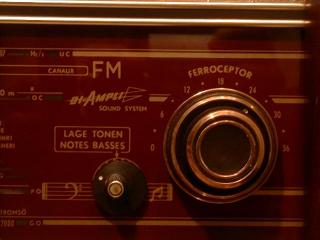
19. Philips Peculiarities
Philips radios are found a lot in The Netherlands.
Indeed, Philips was among the world's leading radio manufacturers during the nineteen fifties.
The company had (and still has) very large research departments and developed a few typical circuits as part of its radio production "culture".
This short article discusses a few of these.
If you think there are other features very typical for Philips and they should be mentioned here, please send me an email.
The Pentode tube
Pentode tubes were invented at the Philips Research Laboratories (NatLab) in 1928.
They aren't however, a typical Philips peculiarity, because they were used by all radio manufacturers since then.

The Four Tube Circuit
Around 1940 Philips designed a new tube series, the loctal tubes.
With these, it became possible to combine the IF amplifier and AF preamp in a single tube, and this reduced the number of tubes in a small radio to four.
This circuit was used in many Philips radios throughout the forties, and Tesla (Czechoslovakia) continued using it far into the fifties.
Another article discusses the principle in more detail.
 The Philips engineers had found out that at low volumes,
the human ear is less sensitive for very high and very low audio frequencies.
Consequently, when the volume of a radio is turned down,
it appears as if the high trebles and low basses are cut off.
The volume controls with four connections that puzzle
many radio collectors are an attempt to correct this.
The Philips engineers had found out that at low volumes,
the human ear is less sensitive for very high and very low audio frequencies.
Consequently, when the volume of a radio is turned down,
it appears as if the high trebles and low basses are cut off.
The volume controls with four connections that puzzle
many radio collectors are an attempt to correct this.
A normal potmeter has three connections:
A top to feed the audio,
a ground,
and a runner that takes the signal from a varying section of the potentiometer.
Philips potmeters have a fourth one, a tap that feeds back some of the trebles and basses to a point (quite low) on the potentiometer.
When the volume is reduced, the frequencies fed to the tap are reduced less.
Sometimes, there are even two taps for more complicated correction,
as in the B5X92A;
schema depicted on the left.
Sometimes the correction overreacts:
then at low volume the sound seems to contain
more bass and treble than at higher volume.

Series Balanced Output
Philips was a tube producer before it started making radios.
For Philips, tubes were virtually for free, while for output transformers the company had to pay.
So what about an invention that allows you to use an extra output tube instead of an output transformer..... and gives better sound quality too?
It almost goes without saying that for Philips the series balanced output stage (click for more technical information) was quite popular.

Bi-Ampli
An extremely succesful invention was the bi-ampli principle, introduced around 1953.
True bi-ampli radios featured two output amplifiers:
one for the basses and one for the high notes;
in this way the different frequencies could not interfere with each other in the output stage.
All bi-ampli radios have separate loudspeakers as well.
Sometimes each amplifier consisted of a single tube,
an EL84 for example, as in the BX750A.
This radio already sounds better than my modern stereo installation with Magnavox loudspeakers!
The big Philips BX998A had a more powerful setup for the basses:
there a series balanced output of 2xPL81 was employed.
In this radio also the amplification stage
preceding the output is separate for high and low frequencies.
I have also seen a radio (Aristona) with two sbo's,
so four (UL41) output tubes together, one sbo for basses and trebles each.
Later the term devaluated a bit when stereo amplifiers were introduced in radios.
Plano radios of the early sixties had "Bi-ampli" on their dial, but only had the option to switch different tone filters in the two output amplifiers when used in mono mode.

Rectifier Tubes
Again, Philips was a tube producing company almost from the start.
Therefore, in a Philips radio you will almost always find
a rectifier tube (or two),
even in the early sixties when all other manufacturers
had already switched to selenium rectifiers.
In the late thirties and forties, the most used rectifier was the AZ1,
around 1950 it was the AZ41, and then came the EZ80.
For some big radios the EZ80 couldn't rectify enough current,
so the radio (BX750A for example)
had two of them.
Later came its more heavy, but pin-compatible, brother EZ81.
Depicted is the Philips B5X43A of 1964,
a stereo radio with the EZ81 rectifier.
Cheaper radios of the same period,
like the B1X42A, used a selenium rectifier.

Complicated dial chord drive
Philips is notorious for their weirdly complicated dial drive schemes.
In this Philips BX380U,
the dial pointer rotates over 180 degrees, fully in sync with the tuning capacitor.
Most manufacturers would dive the whole assembly with a single chord,
running over the knob axis and the capacitor,
and place the pointer on the same axis.
Not so Philips!
The knob drives the wheel on which the pointer is placed, using two pieces of wire.
Then, from this wheel to the condenator drive right behind it,
there are again two wires, steel this time, running through bowden cables.







